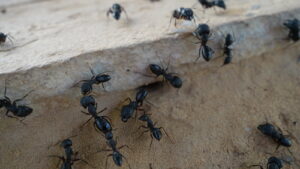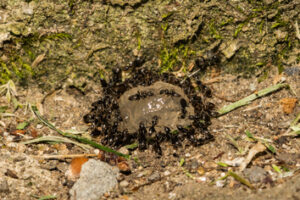Ants, Moisture, and Pest Control
By Zachary Ciras on April 23, 2025.
 Ant infestations in homes are a common issue, with species like carpenter ants (Camponotus spp.) and odorous house ants (Tapinoma sessile) frequently exploiting specific environmental conditions to thrive. Moisture and moisture-damaged structures play a pivotal role in attracting these pests, creating ideal nesting and foraging opportunities. This article explores the relationship between ants, moisture, and moisture damage, drawing on entomological studies, and provides a pest control professional’s perspective on effective management strategies, including the benefits and limitations of chemical controls.
Ant infestations in homes are a common issue, with species like carpenter ants (Camponotus spp.) and odorous house ants (Tapinoma sessile) frequently exploiting specific environmental conditions to thrive. Moisture and moisture-damaged structures play a pivotal role in attracting these pests, creating ideal nesting and foraging opportunities. This article explores the relationship between ants, moisture, and moisture damage, drawing on entomological studies, and provides a pest control professional’s perspective on effective management strategies, including the benefits and limitations of chemical controls.
The Connection Between Ants and Moisture
Ants, particularly carpenter ants and odorous house ants, are drawn to moist environments due to their biological and ecological needs. Moisture facilitates nesting, supports food sources, and enhances colony survival. Below, we examine how these factors influence each species.
Carpenter Ants and Moisture
Carpenter ants are notorious for nesting in moist, decaying wood, which provides a soft medium for excavating galleries. Unlike termites, they do not consume wood but hollow it out to create nests, often exacerbating structural damage in homes. Their preference for damp environments stems from the need for consistent humidity to maintain colony health, especially for rearing brood.
- Entomological Studies: A study by Hansen and Klotz (2005) in The Biology of Carpenter Ants highlights that carpenter ants (Camponotus pennsylvanicus) prefer wood with moisture content above 15%, often found in areas like leaky roofs, poorly sealed windows, or water-damaged crawlspaces. The study notes that parent colonies typically require a moist primary nest, often outdoors, while satellite colonies may exploit drier indoor areas if connected to a moisture source.
- Behavioral Evidence: Research by Akre et al. (1995) in American Entomologist found that carpenter ant colonies thrive in areas with chronic leaks or poor ventilation, such as under sinks or in attics with condensation issues. The presence of sawdust-like frass near these sites is a telltale sign of nesting activity.
Odorous House Ants and Moisture
Odorous house ants, small and dark brown to black, are less destructive but highly adaptable, often nesting in moist, shaded areas close to food sources. Their colonies, which can contain tens of thousands of workers and multiple queens, are known for “budding,” where subcolonies form in response to environmental stress or resource availability.
- Entomological Studies: Buczkowski and Bennett (2008) in Ecological Entomology describe odorous house ants’ preference for moist habitats, such as under mulch, in wall voids near plumbing, or in basements with high humidity. Their study on seasonal polydomy (multiple nest sites) suggests that moisture availability drives nest site selection, particularly in urban settings.
- Foraging Patterns: A study by Scharf et al. (2004) in Journal of Economic Entomology found that odorous house ants are more likely to invade homes during rainy seasons, seeking shelter and exploiting moist areas like kitchens or bathrooms where water and food (e.g., sugary spills) are abundant.
Moisture Damage as a Conducive Condition
 Moisture damage, such as rotting wood, mold growth, or soggy insulation, creates an ideal environment for both carpenter and odorous house ants. Water-damaged wood is softer and easier for carpenter ants to excavate, while odorous house ants exploit damp areas for nesting and foraging. Common sources of moisture damage include:
Moisture damage, such as rotting wood, mold growth, or soggy insulation, creates an ideal environment for both carpenter and odorous house ants. Water-damaged wood is softer and easier for carpenter ants to excavate, while odorous house ants exploit damp areas for nesting and foraging. Common sources of moisture damage include:
- Leaking pipes or roofs
- Poorly ventilated crawlspaces or attics
- Clogged gutters causing water seepage
- Improper drainage around foundations
These conditions not only attract ants but also sustain their colonies, making infestations persistent without addressing the underlying issues.
Pest Control Professional’s Summary
As a pest control professional, the relationship between ants and moisture underscores the importance of integrated pest management (IPM). Carpenter ants and odorous house ants exploit moist environments differently but share a reliance on water-damaged areas. Carpenter ants pose a structural threat by nesting in damp wood, often requiring targeted nest treatments and moisture remediation. Odorous house ants, while less destructive, are persistent due to their polydomous (multi-nest) nature and attraction to moist, food-rich areas. Effective control hinges on identifying and eliminating conducive conditions, such as moisture sources, alongside strategic chemical applications.
Benefits of Structural Pest Control: Sprays and Baits
 Structural pest control, using sprays and baits, is a cornerstone of ant management. These methods target colonies directly or disrupt foraging, offering distinct advantages:
Structural pest control, using sprays and baits, is a cornerstone of ant management. These methods target colonies directly or disrupt foraging, offering distinct advantages:
Sprays
- Spray Insecticides: Slow-acting or non-repellent are highly effective for both carpenter and odorous house ants. Non-repellent sprays allow ants to walk through treated areas, unknowingly transferring the insecticide back to the nest, which can eliminate the colony. For odorous house ants, perimeter treatments around foundations are particularly effective, as they reduce foraging into homes. More repellent insecticidal spray treatments can also prevent the entry of ants as well as a variety of other insects from entering your home. Your Colonial Pest technician will know the pests, the timing, and the current activity or pressure to determine the best course of action to prevent pests in your home. Often, early spring and late summer/fall treatments see benefits from repellent pyrethroids, while non-repellent treatments along the foundation are often best for when ants are actively trailing during the late-May through mid-August timeframe.
- Nest Treatments: For carpenter ants, direct nest treatments with insecticidal dusts, liquid sprays, or direct injection with propelled pyrethroids whether aerosolized or via microinjection are critical. Professional technicians at Colonial Pest are trained to investigate and observe evidence of potential nesting and target each site, ensuring that the colony is eliminated on site. Some foragers may wander for up to 30 days, but will not have the option to pose a threat.
- Rapid Knockdown: Sprays provide quick reduction of visible ant activity, which is essential for client satisfaction in severe infestations. Perimeter treatments, such as those performed during the Preventative Maintenance services, helps to prevent the entry of ants into the home.
Baits
- Colony Elimination: Baits, such as gel baits, liquid baits, or granular baits, exploit ants’ social behavior. Worker ants carry poisoned bait back to the nest, sharing it with the queen and brood, which can destroy the entire colony. Sweet-liquid baits are particularly effective for odorous house ants, who prefer sugary foods.
- Targeted Application: Bait stations can be placed along foraging trails or near entry points, minimizing environmental impact. For carpenter ants, protein-based baits may be used, as their diet includes insects and honeydew. Carpenter ants especially vary in their acceptance of bait formulations depending on seasonality, brooding, and other available resources for food consumption.
- Long-Term Control: Baits provide ongoing control by targeting the colony’s reproductive core, reducing the likelihood of reinfestation compared to sprays alone.
Integrated Approach
Combining sprays and baits enhances efficacy. For example, non-repellent sprays can reduce foraging populations while baits target the nest. This dual approach is particularly effective for odorous house ants, whose multiple nests make complete eradication challenging.
Limitations of Chemical Control
While sprays and baits are powerful tools, their effectiveness is limited if conducive conditions like water damage, overgrown vegetation, or competing food sources persist. These limitations include:
- Water Damage: Unresolved moisture issues, such as leaks or poor ventilation, allow ants to reestablish nests. For carpenter ants, replacing damaged wood without fixing the moisture source invites reinfestation. Studies emphasize that moisture control is critical for long-term carpenter ant management.
- Overgrown Vegetation: Vegetation touching the home provides bridges for ants to enter. Carpenter ants use overhanging branches to access structures, while odorous house ants exploit mulch or leaf litter near foundations. Trimming vegetation is essential but often overlooked.
- Competing Food Sources: Food residues, such as crumbs or pet food, attract ants and reduce bait effectiveness. Odorous house ants, with their preference for sweets, are particularly drawn to kitchen spills. Cleaning and sealing food sources are critical to support chemical controls.
- Colony Budding: For odorous house ants, repellent sprays can stress colonies, causing them to split into subcolonies (budding), which exacerbates the infestation. Non-repellent products mitigate this risk, but proper application is crucial.
- Environmental Impact: Overuse of sprays, especially outdoors, can harm beneficial insects like pollinators or contaminate waterways. Selective, targeted applications are necessary to minimize ecological damage.
Recommendations for Effective Ant Management
To overcome these limitations, pest control professionals should adopt an IPM approach:
- Inspection and Moisture Remediation: Use moisture meters to identify damp areas and recommend repairs (e.g., fixing leaks, improving ventilation). For carpenter ants, locate nests by following foraging trails or looking for frass.
- Sanitation: Advise clients to eliminate food sources by cleaning kitchens, sealing food containers, and removing pet food promptly.
- Exclusion: Seal cracks, crevices, and entry points, and trim vegetation away from the home to reduce access.
- Targeted Chemical Controls: Use non-repellent sprays for perimeter treatments and baits tailored to the ant species’ dietary preferences. Avoid repellent sprays for odorous house ants to prevent budding.
- Monitoring and Follow-Up: Regular inspections ensure treatments remain effective, especially for persistent odorous house ant colonies.
Conclusion
The relationship between ants, moisture, and moisture damage is well-documented in entomological research, with carpenter ants exploiting damp wood for nesting and odorous house ants thriving in moist, food-rich environments. As a pest control professional, addressing these infestations requires a comprehensive strategy that combines chemical controls (sprays and baits) with environmental management. While sprays offer rapid knockdown and baits target colonies, their success depends on eliminating conducive conditions like water damage, overgrown vegetation, and competing food sources. By integrating moisture remediation, sanitation, exclusion, and targeted treatments, homeowners can achieve long-term ant control and protect their properties from these persistent pests.